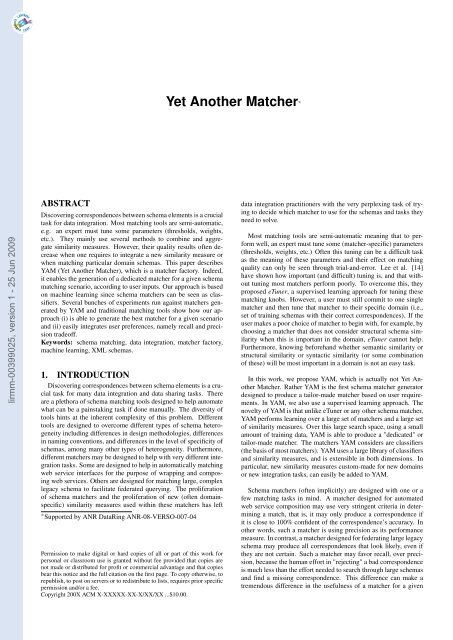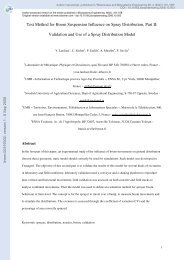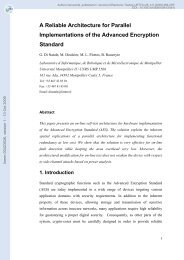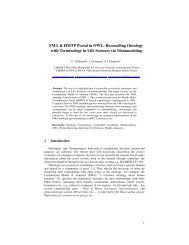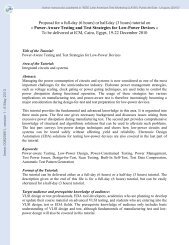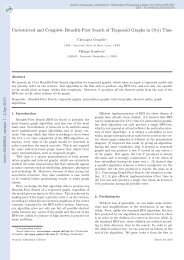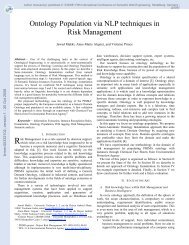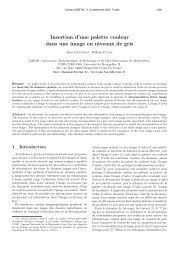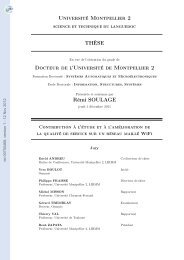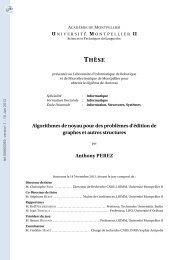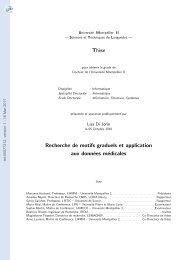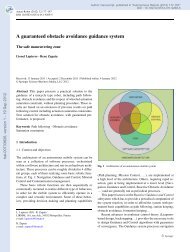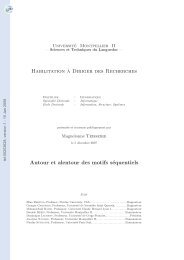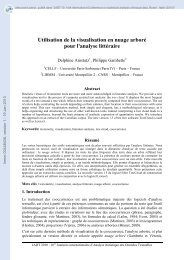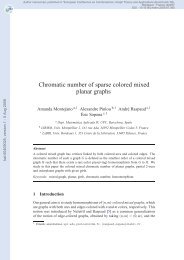Yet Another Matcher
Yet Another Matcher
Yet Another Matcher
Create successful ePaper yourself
Turn your PDF publications into a flip-book with our unique Google optimized e-Paper software.
lirmm-00399025, version 1 - 25 Jun 2009<br />
ABSTRACT<br />
Discovering correspondences between schema elements is a crucial<br />
task for data integration. Most matching tools are semi-automatic,<br />
e.g. an expert must tune some parameters (thresholds, weights,<br />
etc.). They mainly use several methods to combine and aggregate<br />
similarity measures. However, their quality results often decrease<br />
when one requires to integrate a new similarity measure or<br />
when matching particular domain schemas. This paper describes<br />
YAM (<strong>Yet</strong> <strong>Another</strong> <strong>Matcher</strong>), which is a matcher factory. Indeed,<br />
it enables the generation of a dedicated matcher for a given schema<br />
matching scenario, according to user inputs. Our approach is based<br />
on machine learning since schema matchers can be seen as classifiers.<br />
Several bunches of experiments run against matchers generated<br />
by YAM and traditional matching tools show how our approach<br />
(i) is able to generate the best matcher for a given scenario<br />
and (ii) easily integrates user preferences, namely recall and precision<br />
tradeoff.<br />
Keywords: schema matching, data integration, matcher factory,<br />
machine learning, XML schemas.<br />
1. INTRODUCTION<br />
Discovering correspondences between schema elements is a crucial<br />
task for many data integration and data sharing tasks. There<br />
are a plethora of schema matching tools designed to help automate<br />
what can be a painstaking task if done manually. The diversity of<br />
tools hints at the inherent complexity of this problem. Different<br />
tools are designed to overcome different types of schema heterogeneity<br />
including differences in design methodologies, differences<br />
in naming conventions, and differences in the level of specificity of<br />
schemas, among many other types of heterogeneity. Furthermore,<br />
different matchers may be designed to help with very different integration<br />
tasks. Some are designed to help in automatically matching<br />
web service interfaces for the purpose of wrapping and composing<br />
web services. Others are designed for matching large, complex<br />
legacy schema to facilitate federated querying. The proliferation<br />
of schema matchers and the proliferation of new (often domainspecific)<br />
similarity measures used within these matchers has left<br />
∗ Supported by ANR DataRing ANR-08-VERSO-007-04<br />
Permission to make digital or hard copies of all or part of this work for<br />
personal or classroom use is granted without fee provided that copies are<br />
not made or distributed for profit or commercial advantage and that copies<br />
bear this notice and the full citation on the first page. To copy otherwise, to<br />
republish, to post on servers or to redistribute to lists, requires prior specific<br />
permission and/or a fee.<br />
Copyright 200X ACM X-XXXXX-XX-X/XX/XX ...$10.00.<br />
<strong>Yet</strong> <strong>Another</strong> <strong>Matcher</strong> ∗<br />
data integration practitioners with the very perplexing task of trying<br />
to decide which matcher to use for the schemas and tasks they<br />
need to solve.<br />
Most matching tools are semi-automatic meaning that to perform<br />
well, an expert must tune some (matcher-specific) parameters<br />
(thresholds, weights, etc.) Often this tuning can be a difficult task<br />
as the meaning of these parameters and their effect on matching<br />
quality can only be seen through trial-and-error. Lee et al. [14]<br />
have shown how important (and difficult) tuning is, and that without<br />
tuning most matchers perform poorly. To overcome this, they<br />
proposed eTuner, a supervised learning approach for tuning these<br />
matching knobs. However, a user must still commit to one single<br />
matcher and then tune that matcher to their specific domain (i.e.,<br />
set of training schemas with their correct correspondences). If the<br />
user makes a poor choice of matcher to begin with, for example, by<br />
choosing a matcher that does not consider structural schema similarity<br />
when this is important in the domain, eTuner cannot help.<br />
Furthermore, knowing beforehand whether semantic similarity or<br />
structural similarity or syntactic similarity (or some combination<br />
of these) will be most important in a domain is not an easy task.<br />
In this work, we propose YAM, which is actually not <strong>Yet</strong> <strong>Another</strong><br />
<strong>Matcher</strong>. Rather YAM is the first schema matcher generator<br />
designed to produce a tailor-made matcher based on user requirements.<br />
In YAM, we also use a supervised learning approach. The<br />
novelty of YAM is that unlike eTuner or any other schema matcher,<br />
YAM performs learning over a large set of matchers and a large set<br />
of similarity measures. Over this large search space, using a small<br />
amount of training data, YAM is able to produce a "dedicated" or<br />
tailor-made matcher. The matchers YAM considers are classifiers<br />
(the basis of most matchers). YAM uses a large library of classifiers<br />
and similarity measures, and is extensible in both dimensions. In<br />
particular, new similarity measures custom-made for new domains<br />
or new integration tasks, can easily be added to YAM.<br />
Schema matchers (often implicitly) are designed with one or a<br />
few matching tasks in mind. A matcher designed for automated<br />
web service composition may use very stringent criteria in determining<br />
a match, that is, it may only produce a correspondence if<br />
it is close to 100% confident of the correspondence’s accuracy. In<br />
other words, such a matcher is using precision as its performance<br />
measure. In contrast, a matcher designed for federating large legacy<br />
schema may produce all correspondences that look likely, even if<br />
they are not certain. Such a matcher may favor recall, over precision,<br />
because the human effort in "rejecting" a bad correspondence<br />
is much less than the effort needed to search through large schemas<br />
and find a missing correspondence. This difference can make a<br />
tremendous difference in the usefulness of a matcher for a given
lirmm-00399025, version 1 - 25 Jun 2009<br />
task. In YAM, we let a user specify a preference for precision or<br />
recall, and we produce a dedicated matcher that best meets the users<br />
needs. YAM is the first tool that permits the tuning of this very important<br />
performance trade-off.<br />
Like previous supervised-learning approaches to schema matching<br />
[5, 15, 9], YAM requires a knowledge-base containing training<br />
data in the form of pairs of schemas with their (correct) correspondences.<br />
Unlike most matchers, YAM can also take as input a subset<br />
of correct correspondences over the new schemas a user wishes to<br />
match. Such "expert correspondences" are often available. For example,<br />
in matching legacy schemas, the correct correspondence for<br />
some keys of central tables may be known to a user. YAM does not<br />
require such knowledge, but can use it, if available, to produce a<br />
better dedicated matcher.<br />
Contributions. The main interesting features of our approach<br />
are:<br />
• YAM is the first matcher factory capable of generating a dedicated<br />
matcher for a given scenario and according to user inputs.<br />
In the experiments, we show YAM has generated, for<br />
200 schema matching scenarios, different dedicated matchers<br />
(i.e., they are based on different algorithms such as decision<br />
trees, rules, aggregation functions, etc.).<br />
• Our approach integrates a user preference between precision<br />
or recall during the generation process. We demonstrate the<br />
impact of such preference on the matching quality.<br />
• YAM is also able to use correct correspondences when provided<br />
by an user. Indeed, most matchers do not need to focus<br />
on these provided correspondences during generation of the<br />
dedicated matcher. Thus, we observe a strong increase of the<br />
matching quality.<br />
• We finally evaluate our work with traditional matching tools.<br />
YAM achieves comparable results in terms of matching quality.<br />
Outline. The rest of the paper is organised as follows. Section<br />
2 describes the main notions used in the paper. Section 3 gives<br />
an overview of our approach while Section 4 contains the details.<br />
The results of experiments for showing the effectiveness of our approach<br />
are presented in section 5. Related work is described in<br />
section 6. Finally, we conclude in section 7.<br />
2. PRELIMINARIES<br />
In this section, we define the main notions used in this paper.<br />
Then, we describe our schema corpus and quality measures used<br />
for evaluation.<br />
2.1 Definitions<br />
YAM can be applied to match pairs of edge-labeled trees (a simple<br />
abstraction that can be used for XML schemas, web interfaces,<br />
Jason data types, or other semi-structured or structured data models).<br />
Schema matching task can be divided into three steps. The<br />
first one is named pre-match and is optional. Either the tool or<br />
the user can intervene, for instance to provide resources (dictionaries,<br />
expert correspondences, etc.), to set up parameters (tuning of<br />
weights, thresholds, etc.), etc. Secondly, the matching process occurs,<br />
during which correspondences are discovered. The final step,<br />
the post-match process, mainly consists in a validation of the discovered<br />
correspondences by the user.<br />
Definition 1 (Schema): A schema is a labeled unordered tree S =<br />
(ES, DS, rS, label) where ES is a set of elements; rS is the root<br />
element; DS ⊆ ES × ES is a set of edges; and label ES → Λ<br />
where Λ is a countable set of labels.<br />
Definition 2 (Pair): A pair of schema elements is defined as a tuple<br />
< e1, e2 > where e1 ∈ E1 and e2 ∈ E2 are schema elements.<br />
Definition 3 (Similarity Measure): Let E1 be a set of elements of<br />
schema 1, and E2 be a set of elements of schema 2. A similarity<br />
measure between a pair, denoted as Sim(e1, e2), is a metric value,<br />
the similarity value, which indicates the likeness between both elements.<br />
It is defined by:<br />
Sim : e1xe2 → [0, 1]<br />
where a zero value means total dissimilarity and 1 value stands for<br />
total similarity.<br />
Definition 4 (Correspondence): A correspondence is a pair of<br />
schema elements which have a semantic similarity. Correspondences<br />
can be either discovered by similarity measures or given by<br />
an expert. They are defined as follows, < e1, e2, Sim(e1, e2) >.<br />
An expert correspondence has a similarity value equal to 1.<br />
Definition 5 (Schema matching scenario): A schema matching<br />
scenario is a set of schemas (typically from the same domain) that<br />
need to be matched.<br />
Definition 6 (Schema matcher): A schema matcher is an algorithm<br />
which combines similarity measures. Given a schema matching<br />
scenario, it produces a set of correspondences. In YAM, we<br />
consider schema matchers that are classifiers.<br />
2.2 Running Example<br />
Let us imagine that we would like to match two hotel booking<br />
webforms. These webforms are depicted by figures 1(a) and 1(b).<br />
The expert correspondences between their schemas are shown in<br />
figure 2.<br />
Figure 2: Expert correspondences between the two hotel booking<br />
webforms<br />
Figure 3 depicts an extract of the dedicated matcher for this hotel<br />
booking scenario. This schema matcher is based on the Bayes Net<br />
classifier. Each similarity measure is associated with a probabilistic<br />
distribution table. For instance, if the Levenshtein measure returns<br />
a similarity value between −∞ and 0.504386, there is a 99.5%<br />
chance that the current pair of schema elements is not relevant. Using<br />
this dedicated matcher against the hotel booking scenario, we<br />
were able to discover the set of correspondences shown in figure 4.<br />
We notice that 8 out of the 9 relevant correspondences have been<br />
discovered. Two irrelevant correspondences have also been found,<br />
namely (Hotel Location, Hotel Name) and (Children:, Chain).
lirmm-00399025, version 1 - 25 Jun 2009<br />
(a) Webform hotels valued (b) Webform where to stay<br />
2.3 Schema Corpus<br />
To demonstrate the effectiveness of our approach, we used several<br />
schema matching scenarios:<br />
• university describes university departments and it has been<br />
widely used in the literature [10, 7].<br />
• thalia [13] is a benchmark describing the courses offered by<br />
some American universities.<br />
• travel are schemas extracted from airfare web forms [1].<br />
• currency and sms are popular web services which can be<br />
found at http://www.seekda.com.<br />
• web forms is a set of 176 schema matching scenarios, extracted<br />
from various websites by the authors of [15]. They<br />
are related to different domains, from hotel booking and car<br />
renting to dating and betting.<br />
For all these scenarios, correct (relevant) correspondences are<br />
available, either designed manually or semi-automatically. We use<br />
these schemas, and their correct correspondences as the training<br />
data for YAM.<br />
Figure 1: Two hotel booking webforms<br />
Figure 3: Extract of the dedicated matcher<br />
2.4 Quality measures<br />
To evaluate the matching quality, we use common measures in<br />
the literature, namely precision, recall and f-measure. Precision<br />
calculates the proportion of relevant correspondences extracted among<br />
the discovered ones. <strong>Another</strong> typical measure is recall which computes<br />
the proportion of relevant discovered correspondences among<br />
all relevant ones. F-measure is a tradeoff between precision and recall.<br />
We also measured the number of user interactions required<br />
to obtain a 100% f-measure given a set of discovered correspondences.<br />
This measure is described in section 5.5.<br />
3. OVERVIEW OF YAM<br />
YAM (<strong>Yet</strong> <strong>Another</strong> <strong>Matcher</strong>) is a matcher factory tool, which<br />
generates a dedicated schema matcher according to user preferences<br />
and some expert correspondences.<br />
3.1 Motivations<br />
The motivation for our work is the following:<br />
• There is no schema matching tool which performs best for<br />
all matching scenarios. Although matching tools enable the<br />
user to tune some parameters (strategies, weights, thresholds,
lirmm-00399025, version 1 - 25 Jun 2009<br />
Figure 4: Correspondences discovered using the dedicated<br />
matcher<br />
etc.), the same algorithm, for instance, COMA++’s aggregation<br />
function [2], is always used independently of the schema<br />
matching scenario. eTuner [14] automatically tunes schema<br />
matching tools by tuning the input parameters used by the<br />
matcher. Thus, it mainly depends on their capabilities since it<br />
finds the best parameters configuration. Specifically, eTuner<br />
fined the best parameter settings for a given matching algorithm.<br />
On the contrary, YAM is able to produce the dedicated<br />
schema matcher for a given scenario. Each generated schema<br />
matcher has its own features, among which a different algorithm<br />
(aggregation functions, Bayes network, decision trees,<br />
etc.). This is the adaptable feature of our approach.<br />
• User intervention is always required, at least to check the<br />
discovered correspondences. In other systems, users are also<br />
asked to edit synonyms list, reduce schema size [8], or tune<br />
various parameters. In the same spirit, YAM uses some user<br />
inputs, but of a different form. Specifically, YAM can optionally<br />
use a preference between precision and recall, and<br />
some expert correspondences (that is, a small number of correct<br />
matches). This small amount of input enables the use<br />
of supervised learning to create a dedicated schema matcher.<br />
YAM is able to convert user time spent to give preferences<br />
into better quality results. Indeed, most schema matching<br />
tools focus on a better precision, but this does not seem to<br />
be the best choice in terms of post-matching effort, i.e., the<br />
quantity of work required by an expert to correct discovered<br />
correspondences. Technically speaking, it is easier for the<br />
expert to validate (or not) a discovered mapping than to manually<br />
browse two large schemas for new correspondences<br />
that the tool may have missed.<br />
• Some matching tools are said to be extensible, for example<br />
to add new similarity measures. However, this extensibility<br />
is constrained by some parameters, which need to be manually<br />
updated (for instance, adjusting thresholds, re-weighting<br />
values, etc.). Thanks to machine learning techniques and<br />
according to user inputs, YAM automatically learns how to<br />
combine similarity measures into a classifier to produce the<br />
dedicated schema matcher. Thus, our approach is extensible<br />
in terms of similarity measures, but also in terms of classifiers.<br />
Now let us discover what is inside our factory of schema matchers.<br />
3.2 YAM Architecture<br />
To the best of our knowledge, our approach is the first to propose<br />
a factory of schema matchers. The intuition which led to our<br />
work is as follows: the algorithms which combine similarity measures<br />
provide different results according to a given schema matching<br />
scenario. Thus, YAM aims at generating for a schema matching<br />
scenario a dedicated schema matcher. For this purpose, YAM uses<br />
machine learning techniques during pre-match phase.<br />
Figure 5: YAM architecture<br />
Figure 5 depicts the YAM architecture. Circles represent inputs<br />
or outputs and the rectangles stand for processes. Note that a<br />
dashed circle means that this input is optional. YAM only requires<br />
one input, the set of schemas to be matched. However, the user can<br />
also provide additional inputs, i.e., some preferences and/or expert<br />
correspondences. The preference consists of a precision and recall<br />
tradeoff. Expert correspondences (from a domain of interest, or for<br />
the schemas to be matched) are only used by the matcher generator<br />
to produce a better dedicated matcher. YAM is composed of two<br />
main components: the matcher generator is in charge of learning<br />
a dedicated matcher for the input schemas (see section 4 for more<br />
details). This component interacts with the Knowledge Base (KB).<br />
This KB stores previously generated matchers, a set of classifiers, a<br />
set of similarity measures, and expert correspondences which have<br />
already been given or validated. Finally, YAM outputs a schema<br />
matcher, either generated or selected and which is then stored in<br />
the KB. It can obviously be used for matching the input schemas,<br />
thus producing a list of discovered correspondences between the<br />
schemas. Note that the matching process is specific to the classifier<br />
that will be used and is not detailed in this paper.<br />
The current version of YAM includes 20 classifiers from the<br />
Weka library [12] and 30 similarity measures, including all the terminological<br />
measures from the Second String project 1 , and some<br />
structural and semantic measures. YAM’s knowledge base contains<br />
a large set of 200 schemas from various domains (betting,<br />
hotel booking, dating, etc.) gathered from the web.<br />
4. LEARNING A DEDICATED MATCHER<br />
In this section, we describe YAM’s approach for learning a matcher<br />
(which we call a dedicated matcher) for a given matching scenario.<br />
Any schema matcher can be viewed as a classifier. Given the set<br />
of possible correspondences (the set of pairs of elements in the<br />
schemas), a matcher labels each pair as either relevant or irrelevant.<br />
Of course, a matcher may use any algorithm to compute<br />
1 http://secondstring.sourceforge.net
lirmm-00399025, version 1 - 25 Jun 2009<br />
its result – classification, clustering, an aggregation over similarity<br />
measures, or any number of ad hoc methods including techniques<br />
like blocking to improve its efficiency.<br />
In YAM, we use an extensible library of classifiers (in our experiments<br />
including the 20 classifiers from the Weka library [12])<br />
and train them using an extensible library of similarity measures.<br />
(in our experiments including all the measures from the popular<br />
Second String project). The classifiers include decision trees (J48,<br />
NBTree, etc.), aggregator functions (SimpleLogistic), lazy classifiers<br />
(IBk, K*, etc.), rules-based (NNge, JRip, etc.) and Bayes Networks.<br />
The generation of a dedicated matcher can be split into two steps:<br />
(i) training of matchers, and (ii) final matcher selection.<br />
4.1 <strong>Matcher</strong> Training<br />
YAM trains each matcher using its knowledge base of training<br />
data and expert correspondences (if available). We begin our explanation<br />
with an example.<br />
Example: Let us consider the pair (searchform, search) from<br />
our running example. We computed the similarity values of this<br />
pair with each similarity measure in our library. For our example,<br />
let us assume we have three similarity measures: AffineGap = 14.0,<br />
NeedlemanWunsch = −4.0, JaroWinkler = 0.92. From these values,<br />
a matcher must predict if the pair is relevant or not.<br />
To classify an element pair as relevant or not, a classifier must<br />
be trained. YAM offers two training possibilities: either the user<br />
has provided some expert correspondences, with their relevance,<br />
or YAM uses correspondences stored in a knowledge-base (KB).<br />
Note that if the user has not provided a sufficient number of correspondences,<br />
YAM will extract some more from the KB. When the<br />
user has not provided any expert correspondences, the matcher is<br />
learned from the KB, i.e., YAM will use a matcher that provides<br />
the best average results on the KB.<br />
During training, all the thresholds, weights, and other parameters<br />
of the matcher are automatically set. Although each matcher<br />
performs differently, we briefly sum up how they work. First, they<br />
select the similarity measures which provides a maximum of correctly<br />
classified correspondences. Then, the similarity measures<br />
that might solve harder cases are taken into account.<br />
Example: If the user has provided the following expert correspondences<br />
(* City:, City) and (State:, State), string matching measures<br />
like JaroWinkler or Levenshtein will be first considered by the<br />
machine learning algorithms. Indeed, they enable a correct classification<br />
of both pairs.<br />
In general, these algorithms aim at reducing the misclassification<br />
rate. Two errors can occur while training: classifying an irrelevant<br />
correspondence as relevant (a.k.a. a false positive or extra incorrect<br />
correspondence) and classifying a relevant correspondence as irrelevant<br />
(a.k.a. a false negative or a missed correct correspondence).<br />
The first error decreases precision while the second one decreases<br />
recall. Many algorithms assign the same penalty to a false positive<br />
(i.e., an irrelevant pair that has been discovered) and to a false negative<br />
(i.e. a relevant pair that has been missed). To increase recall on<br />
a given dataset, we assign a greater penalty to false positives. Thus,<br />
we should obtain a better recall for a given dataset. Note that promoting<br />
recall (respectively precision) mainly decreases precision<br />
(respectively recall). Our approach is able to generate matchers<br />
which respect a user specified preference for recall or precision.<br />
At the end of this step, YAM has generated a trained matcher for<br />
each classifier in the KB.<br />
4.2 Selecting a Dedicated <strong>Matcher</strong><br />
A dedicated matcher is selected according to its accuracy on the<br />
given training data (KB and possible expert correspondences). If<br />
a user has not provided any expert correspondences, all matchers<br />
have been trained on the KB. Thus, YAM cross-validates each<br />
matcher with the correspondences stored in the KB. On the contrary,<br />
if user has provided correspondences, cross validation is performed<br />
against the given correspondences. Finally, the matcher<br />
which discovered most of the correspondences and the fewest irrelevant<br />
ones is selected as the dedicated schema matcher. Note that<br />
these computations correspond to the f-measure (perhaps weighted<br />
by a user preference for recall or precision).<br />
Example: Let us imagine that we have generated 3 matchers,<br />
named NNge, J48 and SMO. They respectively achieve the following<br />
f-measure during cross-validation: 0.56, 0.72 and 0.30. Thus,<br />
J48 would be chosen as the dedicated matcher.<br />
5. EXPERIMENTS<br />
In these experiments, we first demonstrate that YAM is able to<br />
produce an effective dedicated matcher. Thus, we evaluate the results<br />
of generated matchers against 200 scenarios. Then, we measure<br />
the quality impact according to the number of training scenarios.<br />
Our goal is to show that the amount of training data needed to<br />
produce a high performing matcher is not onerous. Next, we study<br />
the impact of a user preference between recall and precision. Then<br />
we consider the performance of YAM with respect to the number of<br />
expert correspondences. Finally, we compare our results with two<br />
matching tools that have excellent matching quality, COMA++ [2]<br />
and Similarity Flooding [16]. These tools are described in more<br />
detail in section 6.<br />
The schema corpus we use was presented in section 2.3. Experiments<br />
were run on a 3.6 Ghz computer with 4 Go RAM under<br />
Ubuntu 7.10. Our approach is implemented in Java 1.6. In training,<br />
we used 200 runs to minimize the impact of randomness.<br />
5.1 Comparing generated matchers<br />
We begin with a study of which matchers were selected as for<br />
different matching scenarios. This study highlights how different<br />
the performance of each match can be on different scenarios, and<br />
therefore the importance of matching factory tool such as YAM for<br />
selecting among these matchers to produce an effective matcher.<br />
We have run YAM against 200 scenarios, and we measured the<br />
number of times a given matcher is selected as the dedicated matcher.<br />
For this evaluation, we included no expert correspondences, so all<br />
matchers were trained simply with the KB. The KB contained 20<br />
scenarios, and this process took roughly 1400 seconds to produce<br />
a dedicated matcher for each given scenario. Figure 6 depicts the<br />
number of scenarios (out of 200) for which each matcher was selected<br />
as the dedicated matcher. Notice that 2 matchers, VFI and<br />
BayesNet, are selected in half of the scenarios. These two matchers<br />
can be considered as robust as they provide acceptable results<br />
in most scenarios in our KB. However, matchers like CR or ADT,<br />
which have a very low average f-measure on these 200 scenarios<br />
(5% for CR and 28% for ADT), were respectively selected 3 and<br />
10 times. This shows that dedicated matchers based on these classifiers<br />
are effective, in terms of quality, for specific scenarios. Thus,<br />
they can provide benefits to some users. These results support our<br />
hypothesis that schema matching tools have to be flexible. YAM,<br />
by producing different matchers and selecting the best one for a<br />
given scenario, fulfills this requirement.<br />
We also note that aggregation functions, like SLog or MLP, which<br />
are commonly used by traditional matching tools, are only selected<br />
as dedicated matchers in a few scenarios. Thus, they do not provide<br />
optimal quality results in most schema matching scenarios. In the<br />
next section, showing the impact of the parameters, we only keep<br />
the 5 most robust classifiers, namely VFI, BayesNet, NBTree, NNge<br />
and IB1.
lirmm-00399025, version 1 - 25 Jun 2009<br />
Number of Election as Dedicated <strong>Matcher</strong><br />
60<br />
50<br />
40<br />
30<br />
20<br />
10<br />
0<br />
VFI BayNet NBTree NNge IB1 ADT SLog JRip MLP VP IBk CR J48graft J48 FT SMO DecTable<br />
Figure 6: Number of selections as dedicated matcher<br />
5.2 Impact of the Training Scenarios<br />
Figure 7 depicts the average f-measure of several matchers as<br />
we vary the number of training scenarios. Note that the average fmeasure<br />
has been computed over 40 scenarios (randomly selected,<br />
20 runs each). The training scenarios vary from 10 to 50. We note<br />
that two matchers (VFI, IB1) increase their f-measure of 20% when<br />
they are generated with more training scenarios. This can be explained<br />
by the fact that IB1 is an instance-based classifier 2 , thus the<br />
more examples it has, the more accurate it becomes. Similarly, VFI<br />
uses a voting system on intervals that it builds. Voting is also appropriate<br />
when lots of training examples are supplied. NBTree and<br />
NNge also increases their average f-measure from around 10% as<br />
training data is increased. On the contrary, BayesNet achieves the<br />
same f-measure (60% to 65%) regardless of the number of training<br />
scenarios. Thus, as expected, most matchers increase their fmeasure<br />
when the number of training scenarios increases. With<br />
30 training scenarios, they already achieve an acceptable matching<br />
quality.<br />
f-measure<br />
100<br />
90<br />
80<br />
70<br />
60<br />
50<br />
40<br />
30<br />
20<br />
10<br />
VFI<br />
BayesNet<br />
NBTree<br />
NNge<br />
0<br />
IB1<br />
10 20 30<br />
number of training scenarios<br />
40 50<br />
Figure 7: Average f-measure when varying number of training<br />
scenarios<br />
Note that the number of training scenarios is not a parameter<br />
that the user must manage. Indeed, YAM automatically chooses<br />
2 This classifier is named instance-based since the correspondences<br />
(included in the training scenarios) are considered as instances during<br />
learning. Our approach does not currently use schema instances.<br />
the number of training scenario according to the matchers that have<br />
to be learned. We have run more than 11, 500 experiment results,<br />
from which we deduce the number of training scenarios for a given<br />
classifier. Table 1 shows the conclusion of our empirical analysis.<br />
For instance, when learning a schema matcher based on J48 classifier,<br />
YAM ideally chooses a number of training scenarios between<br />
20 to 30.<br />
Number of training scenarios Classifiers<br />
20 and less SLog, ADT, CR<br />
20 to 30 J48, J48graft<br />
30 to NNge, JRip, DecTable<br />
50 BayesNet, VP, FT<br />
50 and VFI, IB1, IBk<br />
more SMO, NBTree, MLP<br />
Table 1: Number of training scenarios chosen by YAM for each<br />
classifier<br />
5.3 Precision vs. Recall Preference<br />
We now present another interesting feature of our tool, the possibility<br />
to choose between promoting recall or precision, by tuning<br />
the weight for false positives. Figures 8(a) and 8(b) respectively<br />
depicts the average recall and f-measure of five matchers for 40<br />
scenarios, when tuning the preference between precision and recall.<br />
Without any tuning (i.e., weight for false negatives and false<br />
positives is equal to 1), this means that we give as much importance<br />
to recall and precision.<br />
For 2 matchers (NBTree and NNge), the recall increases up to<br />
20% when we tune in favor of recall. As their f-measures does<br />
not vary, it means that this tuning has a negative impact on the<br />
precision. However, in terms of post-match effort, promoting recall<br />
may be a better choice depending on the integration task for<br />
which matching is being done. For example, let us imagine we<br />
have two schemas of 100 elements: a precision which decreases by<br />
20% means a user has to eliminate 20% of the irrelevant discovered<br />
correspondences. But a 20% increase in recall means (s)he<br />
has 20% less correspondences to search through among 10, 000<br />
possible pairs ! Hence, this tuning could have a tremendous effect<br />
on the usability of the matcher for certain tasks.<br />
For the three other matchers (BayesNet, VFI and IB1), tuning in<br />
favor of recall has no significant effect. Note that without any tuning,<br />
only one matcher (BayesNet) has an average recall superior to<br />
its precision. Indeed, many of the matchers in our library promote<br />
by default precision. But when setting a weight for false negatives<br />
to 2, then four matchers have a higher recall than precision.<br />
And with a weight for false negatives equal to 3, five other matchers<br />
have reduced the gap between precision and recall to less than<br />
5%. Thus, this shows how YAM is able to take into account this<br />
very important user preference, which directly impacts post-match<br />
(manual) effort.<br />
5.4 Impact of Expert Correspondences<br />
As in Glue [6], the number of expert correspondences is an input<br />
(compulsory for Glue, but optional for YAM) to the system. YAM<br />
can use these expert correspondences to learn better matchers. In<br />
this study, we measured the gain in terms of matching quality when<br />
a user provides these correspondences.<br />
In these experiments, the training phase used 20 scenarios and<br />
expert correspondences were randomly selected. We report the size<br />
of the sets of expert correspondences, providing 5% of expert correspondences<br />
means that we only give 1 or 2 correspondences as
lirmm-00399025, version 1 - 25 Jun 2009<br />
recall<br />
100<br />
90<br />
80<br />
70<br />
60<br />
50<br />
40<br />
30<br />
20<br />
10<br />
VFI<br />
BayesNet<br />
NBTree<br />
NNge<br />
0<br />
IB1<br />
1 2 3<br />
weight of false negatives<br />
4 5<br />
(a) Recall<br />
f-measure<br />
100<br />
90<br />
80<br />
70<br />
60<br />
50<br />
40<br />
30<br />
20<br />
10<br />
VFI<br />
BayesNet<br />
NBTree<br />
NNge<br />
0<br />
IB1<br />
1 2 3<br />
weight of false negatives<br />
4 5<br />
(b) F-measure<br />
Figure 8: Quality of various matchers when tuning weight of false negatives<br />
input. Figure 9 depicts the average f-measure (on 10 random scenarios)<br />
for different matchers.<br />
f-measure<br />
100<br />
90<br />
80<br />
70<br />
60<br />
50<br />
40<br />
30<br />
20<br />
10<br />
VFI<br />
BayesNet<br />
NBTree<br />
NNge<br />
0<br />
IB1<br />
0 5 10 15 20<br />
percentage of provided expert correspondences<br />
Figure 9: F-measure of various matchers when tuning the input<br />
expert correspondences<br />
With only 5% of the correspondences given as expert correspondences,<br />
NNge and IB1 are able to increase their f-measure by 40%.<br />
The classifier NBTree also achieves an increase of 20%. Similarly,<br />
the f-measure of these mathers still increases by as 10% of the correspondences<br />
are provided as expert correspondences. On the contrary,<br />
the VFI and BayesNet matchers do not benefit at all from this<br />
input. Note that providing some expert correspondences does not<br />
require a tiresome effort from the user. 3 <strong>Yet</strong>, this input can improve<br />
the matching quality of most matchers.<br />
5.5 Comparing with Other Matching Tools<br />
We now compare YAM with two matching tools known to provide<br />
an good matching quality: COMA++ and Similarity Flooding<br />
(SF). To the best of our knowledge, these tools are the only ones<br />
publicly available. COMA++ [2] uses 17 similarity measures to<br />
3 Some GUIs already exist to facilitate this task by suggesting the<br />
most probable correspondences.<br />
build a matrix between pairs of elements and aggregated their similarity<br />
values. Similarity Flooding[16] builds a graph between input<br />
schemas. Then, it discovers some initial correspondences using a<br />
string matching measure. These correspondences are refined using<br />
a structural propagation mechanism. Both matching tools are<br />
described in more detail in section 6.<br />
As explained in the previous section, a user does not need to<br />
choose the number of training scenarios. YAM automatically adjusts<br />
this number according to the classifier which is going to be<br />
trained. We have trained YAM against 50 random schemas from<br />
the KB to generate a robust matcher for each schema matching<br />
scenario. Neither COMA++ nor Similarity Flooding can take any<br />
expert correspondence as input. Hence, for this comparison, we did<br />
not include expert correspondences. Similarly, no weight for false<br />
negatives has been set because COMA++ and Similarity Flooding<br />
do not have this capability.<br />
5.5.1 Accuracy Comparison<br />
Figures 10(a) and 10(b) depict the F-measure obtained by YAM,<br />
COMA++ and Similarity Flooding on the 10 scenarios. YAM obtains<br />
the highest f-measure in 7 scenarios, and reaches 80% fmeasure<br />
in 4 scenarios. COMA++ achieves the best f-measure for<br />
currency and university scenarios. SF obtains the best f-measure in<br />
one scenario (travel). In addition, COMA++ is the only tool which<br />
does not discover any correspondence for one scenario (travel).<br />
However, we notice that YAM obtains better results on the webforms<br />
scenarios since it was trained with webforms. With nonwebforms<br />
scenarios, YAM is able to achieve acceptable results.<br />
These results show how our matcher factory relies on the diversity<br />
of classifiers. Indeed, the dedicated matchers that it has<br />
generated for these scenarios are based on various classifiers (VFI,<br />
BayesNet, J48, etc.) while COMA++ and SF only rely on respectively<br />
an aggregation function and a single graph propagation algorithm.<br />
YAM obtains the highest average f-measure (67%) while COMA++<br />
and SF average f-measures are just over 50%. Thus, YAM is a<br />
more robust matching tool, specifically because it is able to generate<br />
matchers based on various classifiers.<br />
5.5.2 Post-match Effort<br />
Most schema matching tools, including most matchers generated<br />
by YAM (without tuning), mainly promote precision to the detri
lirmm-00399025, version 1 - 25 Jun 2009<br />
(a) Non-webforms scenarios (b) Webform scenarios<br />
Figure 10: Precision, recall and f-measure achieved by the three matching tools on 10 scenarios<br />
ment of recall. However, this is not always the best choice for a<br />
given task. The list of discovered correspondences, provided by<br />
matching tools, have two issues, namely (i) irrelevant discovered<br />
correspondences and (ii) missing correspondences. Users first have<br />
to check each correspondence from the list, either to validate or remove<br />
it. Then, they have to browse the schemas and discover the<br />
missing correspondences. Thus, we propose to evaluate this user<br />
post-match effort by counting the number of user interactions. A<br />
user interaction is an (in)validation of one pair of schema elements<br />
(either from the list of correspondences or between the schemas).<br />
f-measure<br />
100<br />
90<br />
80<br />
70<br />
60<br />
50<br />
40<br />
30<br />
20<br />
10<br />
YAM<br />
YAM-tuned<br />
COMA++<br />
0<br />
SF<br />
0 500 1000 1500 2000 2500<br />
number of interactions<br />
Figure 11: Number of user interactions needed to obtain a<br />
100% f-measure<br />
Figure 11 shows the importance of recall by comparing four<br />
matching tools (COMA++, SF, YAM and YAM-tuned, which promotes<br />
recall with a weight for false negatives set to 2). It depicts<br />
user effort, in number of interactions, to reach a 100% f-measure<br />
after that the four matching tools have discovered a list of correspondences<br />
for the sms scenario. Note that this is the worst-case<br />
situation, in which all possible pairs must be checked. For the<br />
user, the first step of the post-match effort consists in (in)validating<br />
discovered correspondences. For instance, YAM-tuned outputs 66<br />
correspondences and thus a user would require 66 interactions to<br />
(in)validate them. At the end of first step, all evaluated matchers<br />
have a 100% precision. During a second step of the post-match<br />
effort, f-measure has the same value distribution for all matchers<br />
(since only recall can be improved). This facilitates comparisons<br />
between matchers. The second step deals with the manual discovery<br />
of all missing correspondences. We assume that all pairs which<br />
have not been invalidated yet must be analyzed by the user. Thus,<br />
to discover the 20% correspondences missed by YAM-tuned, a user<br />
requires about 1600 interactions.<br />
Now let us study figure 11 in more detail. We notice that after the<br />
first step, during which a user (in)validates discovered correspondences,<br />
YAM, COMA++ and SF only increases their f-measures by<br />
a few percent. In contrast, YAM-tuned’s f-measure increases from<br />
32% to 80% with only 66 interactions. As a comparison, with<br />
the three other matchers, there are at least 1100 user interactions<br />
needed to reach this 80% f-measure. Finally, to achieve a 100%<br />
f-measure, YAM-tuned interacts 1600 times with the user while<br />
other tools requires more than 2100 interactions. Note that these<br />
example schemas from sms scenario still have reasonable size, but<br />
with larger schemas, the post-match effort would require thousands<br />
of user interactions. Thus, promoting recall strongly reduces postmatch<br />
effort. In addition, it enables a user to quickly obtain an<br />
acceptable f-measure. Contrary to other matching tools, YAM is<br />
able to take this preference for recall into account.<br />
5.6 Discussion<br />
These experiments support the idea that machine learning techniques<br />
are suitable for the matching task. We have shown the impact<br />
on the matching quality when tuning several parameters, like<br />
the number of training scenarios, the tradeoff between recall and<br />
precision and the number of input expert correspondences. The first<br />
experiment would tailor YAM to automatically adjust the number<br />
of training scenarios according to the classifier to be generated. The<br />
second study demonstrates how YAM can promote recall (or precision).<br />
And the third study describes how users can improve the<br />
quality of their results by providing some expert correspondences.<br />
We finally compared our approach with two other matching tools<br />
to show that YAM outperforms them in most scenarios.<br />
Time performance. Although matching two or more schemas<br />
is not time consuming, generating all classifiers and selecting the<br />
best one is a time consuming process (up to several hours if the KB<br />
of training data is large). This process could be sped up by only<br />
generating a subset of available matchers, which are the most appropriate<br />
according to the features of the schemas to be matched<br />
and user preferences. For instance, if user a wants to promote recall,<br />
YAM can only generate matchers based on BayesNet, tuned<br />
SMO and tuned JRip which empirically demonstrated good results
lirmm-00399025, version 1 - 25 Jun 2009<br />
for this criterion. Of course, in practice, it is the performance of the<br />
dedicated matcher which is crucial and the matchers produced by<br />
YAM have comparable or better time performance to other matchers<br />
(including COMA++ and Similarity Flooding).<br />
6. RELATED WORK<br />
Much work has been done both in schema matching and ontology<br />
alignment. However, we only describe in this section approaches<br />
which are based on machine learning techniques, and the<br />
tools against which we compared our approach. You can refer to<br />
these surveys [11, 17] for more details about other approaches.<br />
In [15], the authors use the Boosting algorithm to classify the<br />
similarity measures, divided into first line and second line matchers.<br />
The Boosting algorithm consists in iterating weak classifiers<br />
over the training set while re-adjusting the importance of elements<br />
in this training set. An advantage of this algorithm is the important<br />
weight given to misclassified pairs. However, the main drawback<br />
deals with the Boosting machine learning technique. Although it<br />
gives acceptable results, we have noticed in section 5 that several<br />
classifiers might give poor results with some scenarios. Thus, only<br />
relying on one classifier is risky. Contrary to our work, the authors<br />
chose to promote precision and do not accept expert correspondences<br />
as input.<br />
MatchPlanner approach [9] makes use of decision trees to select<br />
the most appropriate similarity measures. This approach provides<br />
acceptable results w.r.t other matching tools. However, the decision<br />
trees are manually built, thus requiring an expert intervention. Besides,<br />
decision trees are not always the best classifier, as shown in<br />
section 5.<br />
eTuner [14] aims at automatically tuning schema matching tools.<br />
It proceeds as follows: from a given schema, it derives many schemas<br />
which are semantically equivalent. The correspondences between<br />
the initial schema and its derivations are stored. Then, a given<br />
matching tool (e.g., COMA++ or Similarity Flooding) is applied<br />
against the set of correspondences until an optimal parameters configuration<br />
of the matching tool is found. eTuner strongly relies on<br />
the capabilities of the matching tools. Conversely, YAM learns a<br />
dedicated matcher for a given scenario. It is also able to integrate<br />
important feature like user preference between recall and precision.<br />
Contrary to eTuner, YAM is extensible in terms of similarity measures<br />
and classifiers, thus enhancing the possibilities of our tool.<br />
COMA/COMA++ [2] is a generic, composite matcher with very<br />
effective match results. It can process the relational, XML, RDF<br />
schemas as well as ontologies. Internally it converts the input schemas<br />
as trees for structural matching. For linguistic matching it utilizes<br />
a user defined synonym and abbreviation tables, along with n-gram<br />
name matchers. Similarity of pairs of elements is calculated into<br />
a similarity matrix. At present it uses 17 element level similarity<br />
measures. For each source element, elements with similarity higher<br />
then than threshold are displayed to the user for final selection. The<br />
COMA++ supports a number of other features like merging, saving<br />
and aggregating match results of two schemas. On the contrary, our<br />
approach is able to learn the best combination of similarity measures<br />
instead of using the whole set. It outperforms COMA++ both<br />
in matching quality and time performance.<br />
S-MATCH/S-MATCH++ [3] takes two directed acyclic graphs<br />
like structures e.g., XML schemas or ontologies and returns semantic<br />
correspondences between pairs of elements. It uses external<br />
dictionary Wordnet, to evaluate the linguistic matching along with<br />
its structural matcher to return a subsumption type correspondence.<br />
At present, it uses 13 element level matchers and 3 structural level<br />
matchers. It is also heavily dependent on SAT solvers, which decrease<br />
its time efficiency.<br />
Similarity Flooding [16] has been used with Relational, RDF and<br />
XML schemas. These schemas are initially converted into labeled<br />
graphs and SF approach uses fix-point computation to determine<br />
correspondences of 1:1 local and m:n global cardinality between<br />
corresponding nodes of the graphs. The algorithm has been implemented<br />
as a hybrid matcher, in combination with a name matcher<br />
based on string comparisons. First, the prototype does an initial<br />
element-level name mapping, and then feeds these mappings to the<br />
structural SF matcher for the propagation process. The weight of<br />
similarity between two elements is increased, if the algorithm finds<br />
some similarity between the related elements of the pair of elements.<br />
In a modular architecture, the components of SF, such as<br />
schema converters, the name and structural matchers, and filters,<br />
are available as high-level operators and can be flexibly combined<br />
within a script for a tailored match operation. One of the main<br />
drawback of Similarity Flooding is the matching quality. But this<br />
weak point is compensated by the performance. Our approach goes<br />
further by using different matching techniques selected by a planner.<br />
Glue [6], and its predecessor LSD, are also based on machine<br />
learning techniques. They have four different learners, which exploit<br />
different information of the instances. The name learner (Whirl,<br />
a nearest-neighbor classifier) makes predictions using word frequency<br />
(TF/IDF distance) on the label of the schema elements. The<br />
content learner (also based on Whirl and TF/IDF) applies a similar<br />
strategy on the instances associated to each schema element.<br />
A Naive Bayes classifier considers labels and attributes as a set<br />
of tokens to perform text classification. The XML learner (based<br />
on Naive Bayes too) exploits the structure of the schema (hierarchy,<br />
constraints, etc.). Finally, a meta-learner, based on stacking, is<br />
applied to return a linear weighted combination of the four learners.<br />
First, the user must give some correspondences between the<br />
schemas that require to be matched. These correspondences are<br />
then used for training the learners, and their combination resulting<br />
from the meta-learner is performed against the input schemas<br />
to discover the rest of the correspondences. YAM is also based on<br />
machine learning techniques. However, the user correspondences<br />
are optional, since a knowledge base is provided with our tool. Authors<br />
of Glue do not detail how many correspondences should be<br />
given by the user. We have shown in section 5.2 that some classifiers<br />
require many training scenarios (and thus correspondences) to<br />
be efficient. YAM generates a dedicated matcher, based on a classifier<br />
which best combines all similarity measures. On the contrary,<br />
Glue uses classifiers on the same similarity measures. The metalearner<br />
is a linear regression function, with its drawbacks in terms<br />
of quality and extensibility, as explained in [9].<br />
AUTOMATCH [4] is the predecessor of AUTOPLEX, which<br />
uses schema instance data and machine learning techniques to find<br />
possible correspondences between two schemas. A knowledge base,<br />
called attribute dictionary, contains attributes with a set of possible<br />
instances and their probability. This dictionary is populated<br />
using Naive Bayesian algorithm to extract relevant instances from<br />
Relational schemas fields. A first step consists of matching each<br />
schema element to dictionary attributes, thus computing a similarity<br />
value between them according to the number of common instances.<br />
Then, the similarity values of two schema elements that<br />
match the same dictionary attribute are summed and minimum cost
lirmm-00399025, version 1 - 25 Jun 2009<br />
maximum flow algorithm is applied to select the best correspondences.<br />
The major drawback of this work is the importance of the<br />
data instances. Although this approach is interesting on the machine<br />
learning aspect, that matching is not as robust since it only<br />
uses one similarity function based on a dictionary.<br />
7. CONCLUSION<br />
In this paper, we have presented YAM, a factory of schema matchers.<br />
During pre-match phase, it generates, thanks to machine learning<br />
algorithms, a dedicated matcher for a given matching scenario.<br />
Experiments have shown that the dedicated matcher obtains acceptable<br />
results with regards to other matching tools. Besides, the possibility<br />
to learn matchers whose algorithm is completely different<br />
enables to efficiently match specific scenarios. In the experiments,<br />
our empirical analysis enables to adjust YAM so that it automatically<br />
chooses the number of training scenarios according to the<br />
classifier that it has to generate.<br />
Similarly to other approaches, we enable the user to provide<br />
some initial expert correspondences. As most classifiers are able<br />
to efficiently use this input, generated matchers are better appropriate<br />
for a given matching scenario. As a result, matching quality<br />
strongly increases, even when providing only 1 or 2 expert correspondences.<br />
Our approach is also the first work to let users choose the promoting<br />
of either precision or recall. This choice strongly impacts the<br />
post-match effort, when user (in)validates discovered correspondences<br />
and manually browse schemas to find missing ones. We<br />
have demonstrated that promoting recall is more appropriate to reduce<br />
user post-match interactions.<br />
In the future, we first plan to test more matchers. Indeed, there<br />
exists plenty of machine learning classifiers among which we only<br />
experiment a subset. <strong>Another</strong> ongoing work consists in reducing<br />
the learning time. To tackle this issue, we explore the possibility to<br />
reuse previously generated matchers, which are stored in the KB.<br />
And we intend to use case-based reasoning techniques to select the<br />
dedicated one among them.<br />
8. REFERENCES<br />
[1] The UIUC web integration repository. Computer Science<br />
Department, University of Illinois at Urbana-Champaign.<br />
http://metaquerier.cs.uiuc.edu/repository, 2003.<br />
[2] D. Aumueller, H. H. Do, S. Massmann, and E. Rahm.<br />
Schema and ontology matching with coma++. In SIGMOD<br />
Conference, Demo paper, pages 906–908, 2005.<br />
[3] P. Avesani, F. Giunchiglia, and M. Yatskevich. A large scale<br />
taxonomy mapping evaluation. In International Semantic<br />
Web Conference, pages 67–81, 2005.<br />
[4] J. Berlin and A. Motro. Database schema matching using<br />
machine learning with feature selection. In CAiSE, 2002.<br />
[5] A. Doan, P. Domingos, and A. Y. Halevy. Reconciling<br />
schemas of disparate data sources: a machine-learning<br />
approach. In SIGMOD, pages 509–520, 2001.<br />
[6] A. Doan, J. Madhavan, R. Dhamankar, P. Domingos, and<br />
A. Y. Halevy. Learning to match ontologies on the semantic<br />
web. VLDB J., 12(4):303–319, 2003.<br />
[7] A. Doan, J. Madhavan, P. Domingos, and A. Halevy.<br />
Ontology matching: A machine learning approach. In<br />
Handbook on Ontologies in Information Systems, 2004.<br />
[8] C. Drumm, M. Schmitt, H. H. Do, and E. Rahm. Quickmig:<br />
automatic schema matching for data migration projects. In<br />
CIKM, pages 107–116. ACM, 2007.<br />
[9] F. Duchateau, Z. Bellahsene, and R. Coletta. A flexible<br />
approach for planning schema matching algorithms. In OTM<br />
Conferences (1), pages 249–264, 2008.<br />
[10] F. Duchateau, Z. Bellahsene, and M. Roche. A context-based<br />
measure for discovering approximate semantic matching<br />
between schema elements. In RCIS, 2007.<br />
[11] J. Euzenat and P. Shvaiko. Ontology matching.<br />
Springer-Verlag, Heidelberg (DE), 2007.<br />
[12] S. R. Garner. Weka: The waikato environment for knowledge<br />
analysis. In In Proc. of the New Zealand Computer Science<br />
Research Students Conference, pages 57–64, 1995.<br />
[13] J. Hammer, M. Stonebraker, , and O. Topsakal. Thalia: Test<br />
harness for the assessment of legacy information integration<br />
approaches. In Proceedings of ICDE, pages 485–486, 2005.<br />
[14] Y. Lee, M. Sayyadian, A. Doan, and A. Rosenthal. etuner:<br />
tuning schema matching software using synthetic scenarios.<br />
VLDB J., 16(1):97–122, 2007.<br />
[15] A. Marie and A. Gal. Boosting schema matchers. In OTM<br />
Conferences (1), pages 283–300, Berlin, Heidelberg, 2008.<br />
Springer-Verlag.<br />
[16] S. Melnik, H. G. Molina, and E. Rahm. Similarity flooding:<br />
A versatile graph matching algorithm and its application to<br />
schema matching. In Data Engineering, pages 117–128,<br />
2002.<br />
[17] E. Rahm and P. A. Bernstein. A survey of approaches to<br />
automatic schema matching. VLDB J., 10(4):334–350, 2001.


